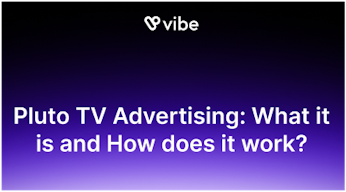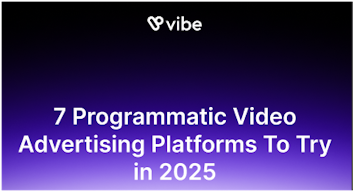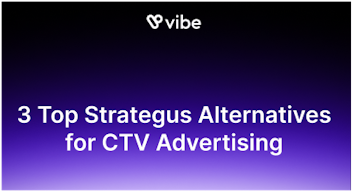Top 10 CTV Marketing Mistakes
Connected Television Advertising is inching into the mainstream for both advertisers and savvy viewers eager to cut expensive cable bundles. Today, 94% of US households are discoverable via connected devices and even legacy ad-free subscription services like Netflix and Amazon Prime are cutting their prices in exchange for ad revenue.
As marketers become more comfortable experimenting with this new medium, however, it’s important to remember that Streaming TV advertising may have the look and feel of a regular TV commercial, but its impact on performance metrics like ROAS and CPV is matchless… when done right.
Here is a list of the top 10 mistakes we’ve helped advertising partners correct over thousands of campaigns.
1. Don’t get stuck on fancy channels
Sure, robust CTV advertising platforms like Vibe.co have partnerships with premium apps, channels, and sports leagues like Disney+, Roku, or the NFL, but ear-marking an entire budget line item for one or two channels that are probably more expensive (and less likely to share contextual data) than hundreds of other newer or more niche channels would be a miscalculation.
Spending your entire CTV ad budget with Hulu, for example, is akin to spending all of your social media budget on just one social platform - no one does that.
Instead, work with platforms that can give you an impactful mix of niche streaming services, FAST channels, live sports league targeting, and high-octane publishers like Peacock or Fox.
Holistic content targeting in this fashion will allow you to reach a vast audience and gain far more insights into your campaign’s impact across the board, especially now that paid subscription viewership is plummeting and original content is drying up due to last year’s SAG AFTRA strikes.
2. Don’t measure the wrong KPIs
Because CTV sounds a heck of a lot like “TV,” advertisers might be tempted to follow the same performance indicators on the latter than on the former, but that’s a mistake, especially for brands looking for performance. While CTV advertising will deliver strong completion rate and unique reach figures (as linear TV does), it can also track cross-device impact like site visits, clicks, or purchases across campaigns.
Platforms like Vibe.co offer integrations with all kinds of measurement partners - from incremental reach to install attribution - but most of the time a simple pixel placed on your web header will unlock web traffic and purchase attribution capabilities as well as retargeting, right from your platform dashboard.
3. Don’t underestimate audience targeting
Different campaigns need different tactics and, thankfully, nimble CTV advertising platforms can now offer targeting and attribution tools to suit every step of the sales funnel (or flywheel, or whatever we’re calling it these days). One such tool is audience targeting with both 1st party (CRM, web visits) and 3rd party data (in-house and purchased audiences), which allows advertisers to follow audiences across platforms and devices.
Make sure at least some of your ad sets focus on targeting personas (by income, interest, demo, and more) while leaving other targeting dimensions open, even if you run channel or time-slot focused ad sets concurrently.
An audience-first strategy will allow you to avoid the pitfalls of CTV fragmentation and optimize performance across channels, audiences, and devices.
4. Don’t be afraid of automation
Direct private deals may sound safer, but reputable CTV ad platforms have extremely reliable fraud prevention protocols that allow them to bid for ads programmatically with excellent placement visibility. They also facilitate more efficient, less expensive, more agile campaigns by using advanced algorithms and real-time data to automate the buying process, allowing for better targeting and improved efficiency.
Advertisers can now reach audiences based on a wealth of data such as viewing habits, interests, location, and more, in just a few clicks. Meanwhile, performance data segmented by targeting dimension, creative, date, and pricing, is available in real-time to facilitate campaign optimization and limit wasted impressions.
Your team will save precious time and money so you can focus your efforts on measurement, testing, and optimization.
5. Don’t shy away from experimentation
One of the most impactful ways in which Connected Television advertising has transformed media buying is by allowing advertisers to measure and optimize their campaigns in real-time. Advertisers can set their budget, campaign timeline, and targeting parameters in a few clicks, and edit them all based on performance without pausing the campaigns at any point. Some of the most successful campaigns we’ve seen have taken full advantage of these capabilities by dividing their campaigns (and budgets) into separate ad sets in order to test creative impact (with or without a QR code, for example), channel reach, frequency caps, and much more.
Once results start rolling in, they can decide how to leverage that data in the moment and allocate more of their budget to the strategies making a real impact on their bottom line.
6. Don’t be coy
Just as TV formats have evolved, so have viewer expectations, and while it’s important to remember that CTV ads will generally be consumed on a large screen and should adhere to that premium format, audiences have come to expect quick, clear, relevant messaging from their video platforms. This is especially true for in-market audiences who already have an interest in engaging with your ad and calls to action.
The majority of CTV ad slots today are either 15s or 30s long, and while there may be a slight bias towards the 15s length for performance-focused campaigns, what really makes a difference is the presence of a brand name, url, and CTA on-screen, ideally for the entirety of the ad.
Some marketers might feel sheepish delivering their message in such an unsubtle way, but it’s important to remember that short display videos, UGC, and muted social media creatives have transformed the way consumers interact with video assets. Yes, they still respond to emotionally resonant content, but they are also much more tolerant of clear, concise promotional information, especially for products and services they are already in the market for.
7. Don’t work with the wrong platform
If you’re heeding our advice and choosing to work with a programmatic CTV ad platform, it’s important to know which questions to ask before launching a campaign. Here are some of the capabilities to look at::
- Scale - They should have access to hundreds of streaming apps, channels, and ideally some live sports programming too.You should be able to target audiences precisely and still have enough reachable households to successfully deliver your ad to enough viewers for your campaign to have an impact.
- Premium inventory - While it’s important to have reach and access to niche channels, there’s nothing like a few placements on popular channels for visibility. It’s also a gauge of the platform’s maturity and power. Look for top streaming channels in their inventory like Pluto, Disney+, or Peacock.
- Strong AI - As the CTV advertising landscape becomes increasingly competitive, traditional linear advertisers and broadcasters are flocking to demand-side platforms with mature bidders to target highly localized audiences more effectively. Make sure you select a DSP with a robust bidder (the algorithm which matches demand and offer requests) that have had time to develop their machine-learning enough to optimize your auction win rates and keep your CPMs (Cost Per Thousand Impressions) low.
- Excellent UI - A solid DSP needs to provide its users with an impeccable user experience in order to fully deliver on CTV’s promise of radical transparency and empower them to optimize campaigns at will. At Vibe.co, for example, we like to think of ourselves as the “Google Ads of CTV,” because the process our clients go through to launch their campaigns is as simple - and familiar - as it is on legacy digital platforms.
- Solid Measurement - Make sure your CTV advertising partner platform has the right integrations, software, and processes to facilitate pixel tracking, GA4 data sharing, retargeting, incremental reach measurement, and real-time ROAS reporting.
8. Don’t forget about frequency and creative refresh
The ability to test and experiment with CTV campaigns is a huge benefit, but it can also be a challenging new habit to form. Top performing campaigns on streaming TVs are usually ones that have gone though a few rounds of frequency cap testing and creative refreshing. Thankfully, tools like Vibe.co’s multi-strategy campaign module empower advertisers to set up as many caps and video assets as they need to garner insights in real-time and optimize their campaigns accordingly.
9. Don’t rely on QR codes for clicks
We all gasped when Coinbase launched their 2022 Superbowl ad showing a small bouncing QR code that still managed to attract so many visitors it crashed the app. Talking heads across the country declared the birth of “QR code marketing,” hundreds of custom QR startups were launched, and then… nothing happened.
We do not discourage the use of QR codes entirely, especially for mobile apps that can link directly to their homescreen, but apart from the one exceptional example above, the number of scanned codes has never been a reliable attribution KPI. Streaming TV advertisers are much better served placing a pixel on their site header to measure CTV-enabled site visits or clicks than waiting for QR codes to affect their bottom line. As interactive ad formats continue to crop up across streaming platforms, we expect the appeal of QR codes to continue lessening.
10. Don’t neglect audio!
We often recommend 1st time CTV advertisers worried about video asset production should repurpose existing social assets for low-cost testing. A major caveat to this strategy, however, is to make absolutely sure to rework audio. Most social ads are muted by default and rapidly scrolled through, but CTV ads are longer, unskippable, and played with the volume on high. Sound is an intrinsic part of TV advertising - make the most of it!
Feeling ready to launch a CTV campaign? Reach out to our experts!



